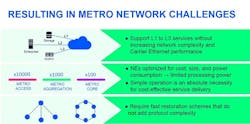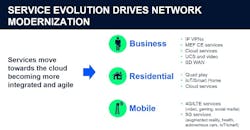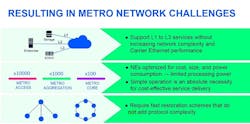Why Waiting for 5G is the Wrong Metro Network Strategy
Today’s metro networks are rapidly evolving and have carriers in a conundrum. Pressured by exploding mobility, major initiatives to move to the cloud, and skyrocketing consumption of high-bandwidth services on one end and the promise of 5G right around the corner, most are deciding between spending now to meet today’s demand or waiting to put the investment towards 5G when the time is right. Is there a right answer? In short, there is – if implemented intelligently.
Tier 1 service providers are making plenty of noise around the build towards 5G, with AT&T and Verizon aiming to light up 5G in some U.S. markets in 2018. Currently, it appears we’ll see 5G networks arrive for major markets around the world in late 2019 or 2020.
But can we wait until then to upgrade? The demands on the metro network are out of control. Metro infrastructure is tasked with constantly consolidating a massive amount of traffic from mobile, residential, and business services, acting as the critical bridge between the service provider core and end-user access. As a result, when demand for connectivity expands due to bandwidth-hungry services such as video streaming, gaming, cloud-based business services, and virtual and augmented reality, it is the metro network that primarily meets the need.
Adding to the metro network pressure cooker is the fact that users today expect consistently high quality of service (QoS). And customer attrition is as easy as picking up the phone. The advent of 5G mobile and explosion of Internet of Things (IoT) will undoubtedly contribute to the strain (Figure 1).
Figure 1. Services are evolving rapidly, increasing the pressure on metro networks.
A metro-sized conundrum
When deciding on how to best manage the metro network to efficiently maximize network agility ahead of 5G, there are two options: Do nothing rather than potentially having to rip and replace when upgrading to 5G, or gear up now and start adding value to current service offerings. Neither is an inexpensive option, thanks to the perfect storm of market trends and increasing traffic in the metro.
Let’s explore these options in more detail:
- Do nothing -- there’s already enough chaos to focus on! Why invest in metro upgrades today if we’ll have to rip and replace when 5G comes along? Side effects to waiting may include minimal growth in the near-term as competitors thrive – perhaps even losses if the network fails to keep pace with incremental increases in demand for high-bandwidth services, which will also be multiplying. Standing pat sadly may also find network services going down the metaphorical tubes of commoditization. Not investing in current infrastructure is likely to affect the end-customer’s quality of experience well before 5G comes along.
- Gear up and start adding value to current service offerings. This route enables service providers to use their metro evolution to diversify portfolios, create new revenue streams, and compete on more than just price. At the same time, they can leverage strategic upgrades to increase capacity with minimal investment, knowing that it will deliver ROI through and past the advent of 5G.
It’s clear service providers should take a proactive stance and gear up. This is easier said than done, however, especially when you consider the potential challenges:
- Increasing capacity to cope with bandwidth-hungry new services
- Rethinking business models to be able to offer assorted services for customers and new revenue streams
- Maintaining flexibility while meeting customers’ needs for different types of connectivity, upgradability, and virtualization services
- Scaling to manage issues that arise from the exploding number of connection points caused from increasing devices in the business, home, and (eventually) on the road
- Meeting the inevitable challenges of securing this flood of new end-points.
Despite these challenges, service providers will benefit in the long run from upgrading and adapting their metro networks today, ahead of 5G. They can grow alongside the bandwidth explosion, without worrying that their equipment and solutions will become obsolete or require the old rip and replace.
The “metro” difference
Customer demands for bandwidth and capacity are causing service providers to look eerily similar. Differentiation is difficult in the age of “more, more, more” and only getting more extreme as whitespace between competitor service offerings shrinks. The result is the unfortunate commoditization of services and connections.
Growth and profits are always affected when an industry faces this situation, wherein competition is based on price rather than service innovation. Now, connectivity itself is undergoing this commoditization – and service providers are simply joining Dot A to Dot B at the smallest possible cost to the customer. Sadly, it’s another race to the bottom, occurring throughout the industry.
An ideal solution here centers on the metro network and sparking innovation with new, differentiating products and services now before 5G becomes the standard. Catching up will be nearly impossible when 5G hits.
Embracing the metro evolution
Service providers have cost-effective approaches at their disposal that will enable them to overcome today’s challenges and put them in position for tomorrow’s 5G disruption. The first major initiative is to select a multifunction metro aggregation platform that facilitates key activities in the metro evolution ahead of -- and through -- 5G (Figure 2).
Figure 2. The right metro aggregation platform must prepare the network for the evolution to 5G, while also
supporting services innovation in the meantime.
Here, then, are a few important platform qualifications service providers should look for as they consider the current state of the market and the inevitable revolution 5G will bring.
- Easy upgrades: Most network platforms today operate at 10 or 40 Gbps. But service providers will require the ability to easily upgrade to 100 Gbps without ripping and replacing existing components. They’ll want to simply swap cards rather than replace the whole kit.
- Flexible first: Operator should seek a flexible platform that supports IP-MPLS as well as easy evolution into segment routing. The system also should help streamline day-to-day business and solve today’s most difficult operational challenges.
- Highly secure: It’s vital that the platform come fully equipped with security embedded at the design level, rather than added on with various unrelated products and services. The “endpoint explosion” ushers in a new generation of vulnerabilities, which must be dealt with via Internet Protocol Security (IPSec), Media Access Control Security (MACSec), and/or Layer 1 encryption.
- Intelligent: In today’s age of networking, intelligent management and traffic engineering are integral elements of a metro aggregation strategy. With deterministic network traffic control and visibility, along with local caching to reduce backhauling traffic to the core, service providers can reduce investments in capacity while ensuring QoS.
- Support XaaS, SDN, and NFV: Operators should consider adding an NFVi blade for multi-access edge computing (MEC) to run different network functions such as security, caching, and routing. Or having an inherent evolution plan to software-defined networking (SDN), by either enabling SDN functionality today, or at the very least supporting open connectivity with NETCONF/YANG. This way, operators ensure a successful transition to SDN whenever they are ready.
Coming Together
5G backhaul will require complex multipoint networks to accommodate new services such as the resulting explosion of IoT, industrial IoT, autonomous cars, and transport networks as a whole. Yet, before then, the network still needs to address today’s point-to-point private connections. Migration and/or investments to a better-fitting metro network, therefore, have to be both simple and practical, and ensure that investments today continue generating ROI into the 5G era.
A network that enables this migration smoothly, rather than requiring tearing out previous network infrastructure and components, allows the proper innovation of services necessary to avoid commoditization today without concern for such investments becoming redundant tomorrow. The most successful metro approach will also be easily scalable for “pay as you grow” expansion. To meet the evolving service needs and huge capacity growth, the platform will need to enable seamless interworking between IP and optical transport.
Service providers are thinking ahead, but the road is unclear. Investments in some approaches aren’t likely won’t realize full product lifecycle and concurrent long-term ROI because they will need to be replaced to realize 5G’s full potential. In embracing platforms that enable rapid service innovations today that carry onward through 5G and beyond, service providers can thrive in the metro evolution driven by mobility trends, high-bandwidth services of the future, and the digital transformation in general.
Jimmy Mizrahi is executive vice president, global portfolio, at ECI Telecom.


